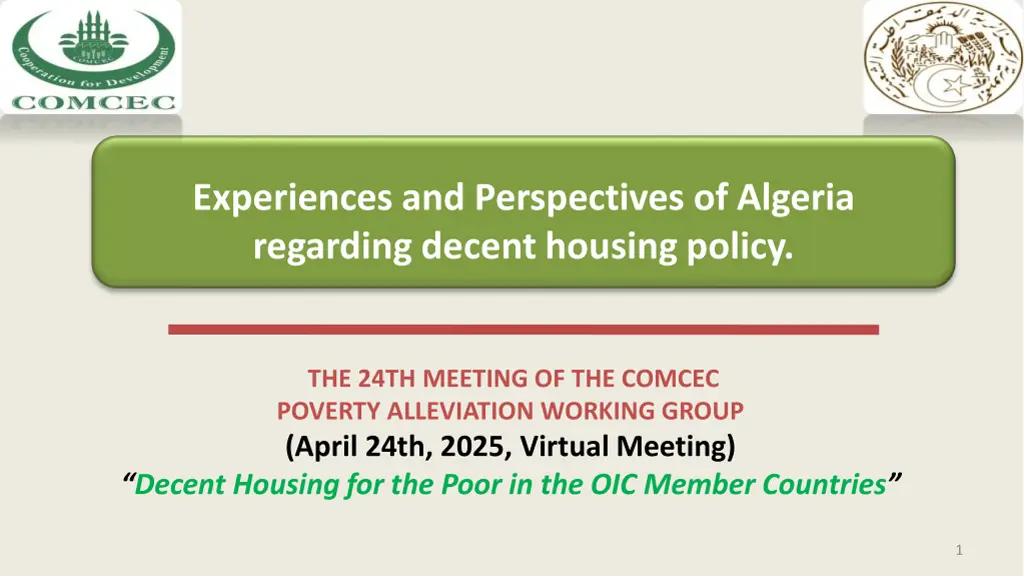
Algeria's Decent Housing Policy Perspectives
Explore Algeria's initiatives for promoting decent housing through national urban policies, emphasizing social equity, economic growth, and improved living conditions. The government offers subsidies and financing options to enhance housing availability and affordability, focusing on criteria like habitability, safety, and accessibility.
Download Presentation

Please find below an Image/Link to download the presentation.
The content on the website is provided AS IS for your information and personal use only. It may not be sold, licensed, or shared on other websites without obtaining consent from the author. If you encounter any issues during the download, it is possible that the publisher has removed the file from their server.
You are allowed to download the files provided on this website for personal or commercial use, subject to the condition that they are used lawfully. All files are the property of their respective owners.
The content on the website is provided AS IS for your information and personal use only. It may not be sold, licensed, or shared on other websites without obtaining consent from the author.
E N D
Presentation Transcript
Experiences and Perspectives of Algeria regarding decent housing policy. THE 24TH MEETING OF THE COMCEC POVERTY ALLEVIATION WORKING GROUP (April 24th, 2025, Virtual Meeting) Decent Housing for the Poor in the OIC Member Countries 1
PRINCIPAL AIMS OF NATIONAL URBAN POLICY/ FOCUS ON HOUSING PROMOTINGSOCIALEQUITY, STABILITYAND INCLUSION: Providing adequate and affordable housing for lowest (vulnerable) , lower and middle income households in urban and rural areas, including eliminating slums and informal settlements; Reducing the housing deficit by intensifying the production of unites, through different income-basedformulas. INHANCING LIVING CONDITIONS: providing homeswith accessto basic services, facilities and infrastructure. Encouraging urban planning and balanced development. BOOSTING ECONOMIC GROWTH AND EMPLOYMENT : stimulating the constrction sector and creating jobs through housing projets. 2
PRINCIPAL MEANS OF THE THIS POLICY Land Free or Below Market Value -State budget,subsidies -Publics and private banks -Warranty organisations National File Housing - Construction compagnies - Building materials PRINCIPAL MEANS Approved private and public real state developers Supervisory technique research. CNERIB, LNHC, CNIC et ANURB). bodies controls (CTC, for and CGS, local organizations responsible for housing, planning, cities and public facilities administrative Project owners operating across the country (OPGI-AADL-ENPI) urban 3
CRETERIA OF DECENT HOUSING HABITABILITY AND ADEQUATE SPACE AVAILABILITY OF BASIC SERVICES SAFETY- RESILIENCE CRETARIA ACCESSIBILITY AFFORDABILITY SECURITY OF TENURE 4
GOUVERNEMENT SUBSIDIES AND FINANCING INCREASE THE SUPPLY OF AFFORDABLE UNITS EXPLICIT SUBSIDIES: Public Rental Housing fully suported -Direct Financial Aid To Citizens: -Subsidies For Housing Grants -Interest Rate Subsidies -Publics-infrastructure: (Viability, road, network, healthcare, schools and other services) financed from the state national budget 5
FOCUS ON GOVERNMENT SUBSIDIES AND FINANCING -Free or low-cost land allocation IMPLICIT SUBSIDIES (non monetary support) Taxes reduction: (Val) Regsitration Fees Rent supported 6
State-Led Housing: Programs based on income level,social statut, financing capaciy Lowest-income Households (Fully assisted) in urban area Public Rental Housing Rent to own ( LV) Assisted Promotionnel Housing (LPA) lower and Middle Income (partly subsidized housing) urban, sub-urban and rural area. Public promotionnel housing (LPP) Rural Housing Programs (HR) Self-build social subdivision projects Commercial Housing; High Income (Only Regulation) Private Self- Building. 7
Publicn to Rental Housing (LPL) Target population: funded by the budget of the State, this segment is intended to households whose income does not exceed 24000 DA; it may be also intended to re-housing as part of curbing precarious. Eligibility: must meet strict income criteria and prove inadequate living conditions, managed by local authorities ( communes/wilayas). benifits: -allocated without financial contribution from the beneficiary. - built by public developers (OPGI), charging rents less than 10% of the tenant's salary. -Youth support: 40% of units to individuals under 35 years old. -This type of housing can be sold at highly subsidized prices. 8
Rent to own models ( LV) Target population: intended to households whose revenue is included between 24 000 DA and the Guaranteed National Minimum Wage six-fold. Benifits: -benificiaries contribute a portion of the cost, with direct and indirect state subsidy (financial aid, additional costs, viability) -allowing to transition from renting to owening their home over time after repaying with initial contribution and rent paid. -subsidzed pricing: access to long-term,low interest housing loans through public banks ( garanteed by state to AADL with 0% interest (manager of this formula). -digital application process: on line platform for suscribing, ensuring transparency and efficiency in the allocation process. 9
Assisted Promotionnel Housing (LPA) Target population: this type of housing is intended to households whose revenue is included between one and six-fold the Guaranteed National Minimum Wage and 1% interest-rate rebate of loans grantedby banks Benifits: -financial package combining financial aid from the State, personal contribution, subsidized bank credit 1%). -intendedfor home ownership via an off-plancontract. 10
Rural Housing Programs (HR) Target population: this type of housing planned in the rural area is intended for households whose revenue is inferior or equal to the Guaranteed National Minimum Wage six-fold. It benefits from a direct assistance and 1% interest-rate rebate of interest rate of loans granted by banks. Benifits: -provides Financial support for the construction or renovation of rural homes using local materials with technical assistance from local housing services, -Community developpement: improve living conditions in rural areas, promoting balanced regional development. 11
Self-build social subdivision projects in south (sahara region) and H.Plateaux regions (central steppe region) Target population: this type of housing planned in the sub-urban area is intended for households whose revenue is inferior or equal to the Guaranteed National Minimum Wage six-fold. It benefits from a direct financial aid and 1% interest-rate rebate of interest rate of loans granted by banks. Benifits: public land supply for self-construction (200-250 m ), empowering citizens to build homes tailored to their needs . 12
MASS HOUSING CONSTRCTION HOUSING PRODUCTION FIVE YEARS PLAN 2020-2025 Annuel average 40 138 64 064 80 219 65 558 88 733 338 712 (LPL) (LPA) (LV) (LPP) (H.R) LS T/PUBLIC 2020 2021 2022 2023 2024 Total 48 690 97 319 167 096 94 846 90 191 498 142 13 500 14 500 14 200 14075 26 379 82 654 71 000 122 000 111 000 123850 95 109 522 959 3 000 3 000 2 800 366 270 9 436 33 500 60 500 72 000 63 309 178 102 407 411 31 000 23 000 34 000 31 343 53 616 172 959 200 690 320 319 401 096 327 789 443 667 1 693 561 (LPL) 10% home ownership 29% (LPA) 24% 29% Urban (LV) 24% Rural (LPP) 71% Rental 5% (H.R) 1% 76% LS 31% 13
RESULT OF FIVE YEAR PLAN 2020-2024 Near 1,7 million housing units delivered in various format, 45.000 units precarious eliminited . Over 2200 public facilities, including educationnel, healthycare and sportives. Improving housing occupancy rate, which measures the average number of individuals per housing unit (4,18) in 2024. Expanding the national housing stock to over 10,5 million units. 14
PERSPECTIVES AND TRANSFORMATIVES ACTION Continue efforts to improve citizens' living conditions, particularly through the construction of 02 millions housing units in five years plan 2025-2029 in particular launch AADL 03,meeting the diverse needs of citizensin urban and rural areas; Strengthen innovative financing mechanisms, including housing saving schemes and introducingIslamic finance; Implement large integrated housing clusters, guaranteeing quality housing with all amenities; Improve housing accessibility, particularly for young people, families, and vulnerable populations. Focus on quality over quantity , green building materials and energy-efficient designs are slowly gaining ground. 15
PERSPECTIVES AND TRANSFORMATIVES ACTIONS diversification of sources of financing other than public by Strengthening the role of the National Housing Bank, created in 2022, Strategic availability of urban land by digital land management and urban planing reforms by Strengthening the role of the national urban land agency, created in 2023, Encouraging private sector involvement and promote public-private partnerships. Digitalization and transparency in houses allocation. 16






















